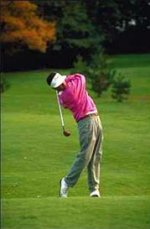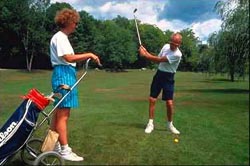|
Big Swing Photos
The lack of a visible ball is a problem. For most sports photography, the first rule is always show the ball in the photo, but that's nearly impossible to do when players are driving off the tee or making iron shots on the fairway, unless you make an image before the ball is hit. Point-and-shoot cameras have one major drawback when used for action photos. There is a delay of a second or two from the time the photographer presses the shutter release until the picture is actually recorded on film. That means, if you're out to capture a golf swing (or a diver in mid-air or a runner stealing home) and you wait to press the shutter until you see the peak of the action in your viewfinder, you won't get the shot you wanted. Unlike a single lens reflex camera (SLR) where the shutter fires at the instant you push the shutter release, point-and-shoot models need a little time to set the correct focus, analyze the exposure and select the proper shutter speed and aperture. That brief delay is no problem if you're taking a photo of the kids in front of the Grand Canyon, because there is no peak moment. But for sports photos, you run the risk of missing the peak action. There's no certain formula for overcoming this problem since all point-and-shoot camera models have a different amount of delay. So, if you use a point-and-shoot, get to know your camera and learn to anticipate peak action and press the shutter a second or two before the peak. Sports photography is one area where single lens reflex cameras have a distinct edge over point-and-shoot models, so if you're really interested in action photography, you should consider using an SLR.
|

